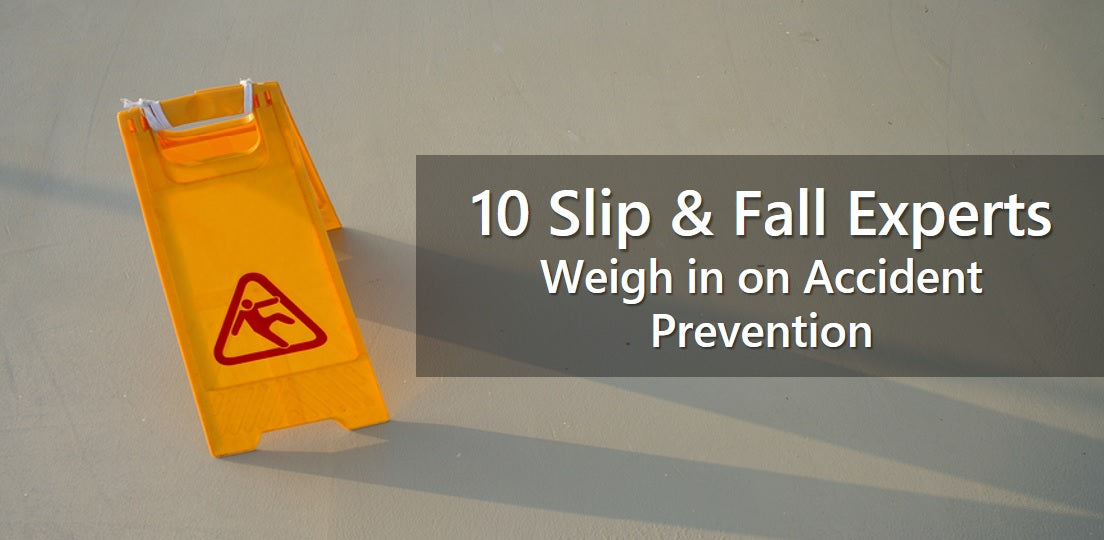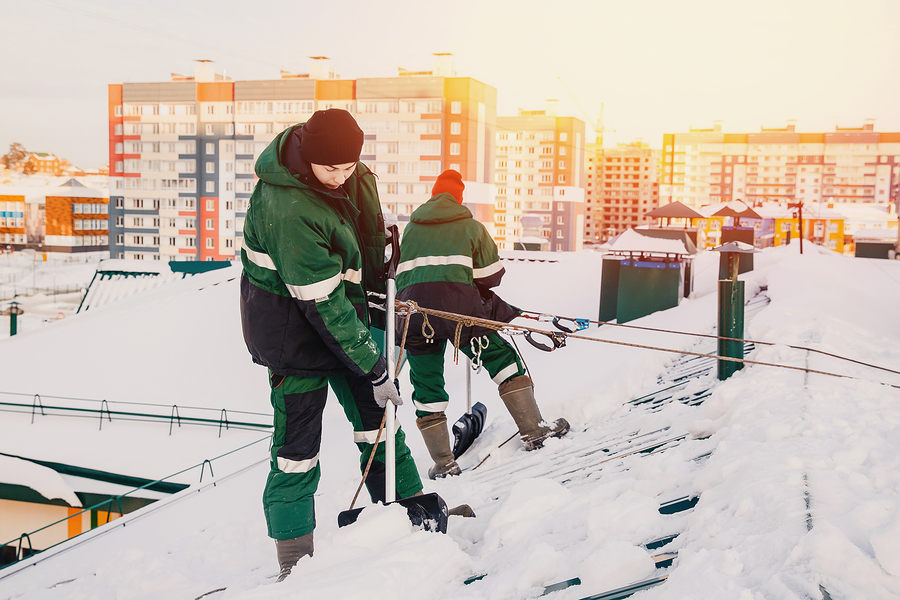
We spoke to ten experts on slips and falls to hear their thoughts on the following topics:
- What is your top piece of advice for slip-and-fall prevention?
- With all the many feet of sidewalks, entrances, and loading docks at any given facility, how should a facility manager decide where to focus resources to prevent slip-and-fall accidents?
- Is there a facility you've seen that has a unique way of dealing with slip-and-fall issues?
Below are their answers.
 Chip Darius, OHST, CET, CSHO, CUSP
Chip Darius, OHST, CET, CSHO, CUSP
OSHA Compliance Consultant, Safety Trainer, Expert Witness/Litigation Consultant
1. For slip-and-fall prevention, keep walkways clean, clear, dry, well-marked, well-lit and in good repair.
2. A facility manager needs to first systematically assess all walkways for defects and make repairs, then determine which walkways are likely to become contaminated from weather or processes and which ones have high pedestrian traffic. Do the most good first: improve areas with high traffic and frequent or predictable contamination. Ask employees where near-misses have occurred, determine why, and engineer away the hazards where possible.
3. In New England, temperatures change a lot, and black ice is a problem. I am a fan of the reflectors that change color when the temperature is near or below freezing. Also, have a sensible footwear policy, and use mats at entrances to reduce inbound dirt and moisture. Train all employees to take personal responsibility to report and warn others about spills or other walkway hazards.
 Jen Walker Desko, MBA
Jen Walker Desko, MBA
Manager, Risk Management
1. My top piece of advice for slip-and-fall prevention in any facility is to implement a solid housekeeping procedure that includes “clean-as-you-go” principles, maintenance and cleaning of walking surfaces, and hazard identification and treatment.
2. The top priority of facility managers with many feet of sidewalks, entrances, loading docks, and other exterior surfaces should be main entrances and frequent walking paths of employees and visitors. While all walking surfaces should be maintained, in the event of inclement weather, main entrances and frequent walking paths should be cleared and treated first, and less-used entrances, loading docks, and side entrances can be cleared afterward.
3. One of the unique, yet simple ways a client of mine dealt with frequent slips and falls was to require that all employees uses cups with lids for coffee, water, and other drinks available from their onsite breakrooms and cafeterias, and to provide these cups. This drastically reduced slips and falls resulting from wet floors in this healthcare setting.
 Matthew Sorg, OHST, CESCO
Matthew Sorg, OHST, CESCO
Safety Manager, Sysco Albany
1. Create awareness by posting signage in high-traffic areas and using anti-slip matting and Treks footwear when appropriate.
2. Resources should be focused mainly where the incidents/accidents are occurring or have a high potential to occur.
3. Heated sidewalks are a unique way to manage these types of issues, though they’re not inexpensive.
 Fred Anderson
Fred Anderson
V.P. Operations, Walkway Auditor Certificate Holder, OSHA Authorized General Industry Trainer at Pilgrim Mat Services
1. To prevent slips and falls, be proactive! Our population has become older and more and more of us have infirmities that limit our mobility. We wear footwear that does not fit properly, we cannot (or do not) step properly as we walk, etc. Our younger generation tends to be multitasking as they walk, and they fail to pay attention to what is in front of them. Pay attention to travel patterns and look for deficiencies in flooring and other things, such as spills on floors. Work to correct them immediately. All your employees need to be alert to unsafe conditions and respond quickly. Use your eyes, they will save lives! Many of us do not know what the coefficient of friction is for the floors we have in place. Find a professional to measure this and establish a baseline. Work from there to assure you maintain or improve the slip resistance of the floor as your results dictate.
2. Facility managers (as a responsible person) have a legal obligation to meet a standard of care set forth by the legal community. Be proactive, have security cameras and systems in place to review footage on a regularly scheduled timeframe. Note your concerns after your review and address them. Use a walkway audit system and maintain this documentation. Show those deficiencies and corrective actions. Use more than one person in your audits, since an extra set of eyes goes a long way. Do all you can to control your traffic patterns without making them cumbersome! Prioritize areas based on your greatest exposure for slips, trips, and falls. Address those concerns that have the highest risk first. Insurance companies can be your greatest asset in helping you establish these procedures. Never ignore “near misses”; by investigating an “almost” accident, you will eliminate many of your claims.
3. I do not consider these facilities unique, but the successful ones seem to have facility managers and budgets established to maintain their facilities properly for their public and employees. They use the budget as it was designed, and the proper capital projects for improvements to their facilities seem to be ongoing. When reviewing these items, they seem to show a return in insurance-premium reductions. They always seem to have the proactive approach that drives their success.
 Donny Beaver
Donny Beaver
CEO at HalenHardy.com
1. Do your homework. Study your slip-and-fall incidents over the past few years to determine the most frequent causes. Then, devise a consistent training program so your workers know how to proactively prevent incidents.
2. Practice the 80/20 rule. Focus your attention on areas that regularly experience wet conditions, such as outdoor stairs, entrances, and ramps, or oily floors and steps around heavy production machinery.
3. Installing long-lasting slip-prevention gripping materials substantially reduces the chance of slipping incidents.
 Ross Greenwood
Ross Greenwood
Non-Slip Solutions Owner
1. Wherever there is wet, slippery tile, have it treated with an anti-slip product. If the floor scores a .5 or better co-efficiency of friction—a measurement of a floor's slip resistance—personal injury lawyers and the courts are likely to decide that a slippery floor was not the cause of the fall.
2. Where there is water on a floor, there is a problem.
3. There is nothing unique. Stop wet, slippery tile/flooring and the problem will be lessened. Keep the surface clean!
 Stephen Papale
Stephen Papale
Slip Solutions of Illinois, DiscoverOptions/OptionVue, Inc.
1. I am a distributor for a non-slip floor product called Sure Step. I always advise in the appropriate situation to use our non-slip treatment or another remedy to increase the coefficient of friction.
2. I would look at the incidents specific to the facility, along with industry statistics, to determine how to allocate resources for prevention.
3. I haven’t really seen a facility with a unique way of dealing with slip-and-fall issues. Most are not aware of the risk until there is an accident, so they do little or the minimum.
 Mario Guindon
Mario Guindon
CRSP (2005-2016), CHSC (retired)
1. While I was working, I developed a slip-and-fall prevention program composed of multiple elements to ensure that it was all-encompassing. However, a slip-and-fall prevention program is not unlike other programs. The most important piece is the individual’s knowledge of proper footwear, diligence about fashion, and recognition of hazards. It sounds simple, and many believe that there is no need to educate people on these matters. However, once you've mentioned to people an important item such as using self-cleaning tread footwear or soles that remain soft in low temperatures for a good grip on slippery surfaces, many will say that they weren't aware that these things were available. Not eliminating surfaces other than outdoor snow and ice is also important. If we provide workers with the knowledge that their slip coefficients change once a surface has water, oils, sand on dry hard surfaces or snow and ice outdoors, this will go a long way toward preventing incidents.
2. A facilities manager needs to focus on priorities: what entrances are required first and what work area needs to be maintained prior to a certain time of day. Once this is decided, then information needs to be communicated and posted for staff about what entrances will be maintained, in what order, and times identified. An example would be that the main entrance should be cleared of hazards first, before staff arrives, and shop areas should be cleared before shop personnel arrive. In many cases, office hours start earlier than some maintenance departments do. Offices may start as early as 6 a.m. and shops at 8 a.m. If this isn't the case in your environment, then office and maintenance staff should consider using the same entrance during winter months. All other entrances that can be used minimally or not at all during the winter, as well as emergency exits, can be maintained after the main work starting time is over. Additionally, one item found to be of some help was having the appropriate staff perform the snow removal. However, if there are boxes at the entrances with materials to be spread over the icy areas and any staff member recognizing the hazard can spread the material throughout the day, this helps the maintenance staff to focus on the other areas requiring snow removal. This is in line with the slogan, "Care enough to act," which allows staff to do their part to prevent accidents.
3. The answer to this question may appear biased. However, the slip-and-fall prevention program at Bruce Power has multiple elements, such as awareness, equipment readiness, calling in to report hazards, safety meeting topic discussions, and slip-prevention safety equipment such as Yaktrax. It is the best program I have seen, and I have performed some benchmarking in this area. Every corporation should look at their own resources and requirements before deciding on their commitment to such a program. However, this program, when implemented with dedication, will result in a positive outcome for your business. One thing that I am very pleased with—and I believe this is unique—is that the slip-and-fall prevention program was designed to help everyone to prevent slips and falls at home so that workers can remain healthy and be able to come to work.
 Bob Caskanette
Bob Caskanette
Environmental and Forensic Engineering Consultant at Caskanette Udall Consulting Engineers
1. My top advice for a property manager is to do regular site inspections, maintain records of problems identified, and fix the problems on a timely basis.
2. Resources should be focused on changes in elevation, such as curbs and settled slabs, where people trip, which should be painted bright yellow so that they are visible.
3. I haven’t seen any unique solutions to the problem.
 William Heavner
William Heavner
Traction Control Solutions, LLC
1. My top piece of advice for slip-and-fall prevention is being proactive. I've seen a lot of lawsuits hinge on whether or not a business was active in preventing a fall. If there is a problem and they do nothing to address it, the verdict against them is much worse.
2. Resources should be focused around entrances where the most moisture is tracked in from rain or snow and around drink stations where a spill from a drink or ice is most likely to occur.
3. Treating all floors is unique and inexpensive. Slip-resistant floors are a requirement of ADA. I know of a restaurant that ripped up their entire floor and replaced it with “slip-resistant” pool tile, and it was still slippery when wet.


